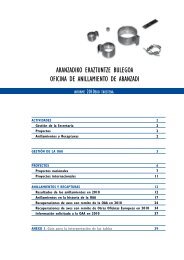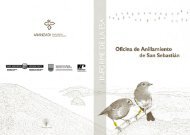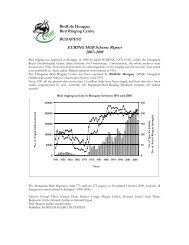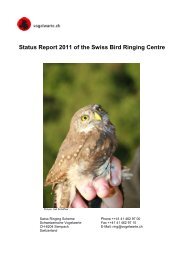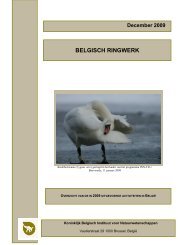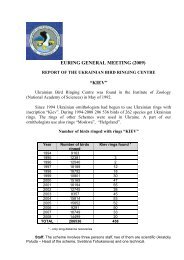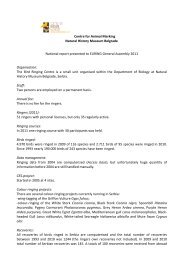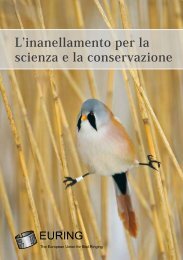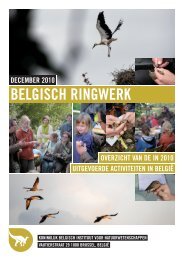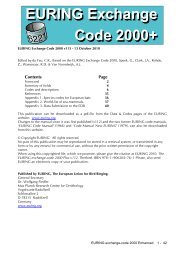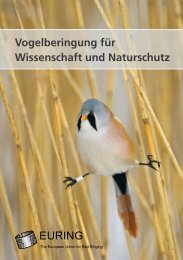Bird Ringing for Science and Conservation - The European Union ...
Bird Ringing for Science and Conservation - The European Union ...
Bird Ringing for Science and Conservation - The European Union ...
- No tags were found...
Create successful ePaper yourself
Turn your PDF publications into a flip-book with our unique Google optimized e-Paper software.
<strong>Bird</strong> <strong>Ringing</strong> <strong>for</strong> <strong>Science</strong> <strong>and</strong> <strong>Conservation</strong><br />
<strong>Bird</strong> <strong>Ringing</strong> <strong>for</strong> <strong>Science</strong> <strong>and</strong> <strong>Conservation</strong><br />
<strong>The</strong> EURING Swallow Project<br />
A worldwide symbol of bird migration all<br />
across its vast geographical range <strong>and</strong> <strong>for</strong><br />
different human cultures, the Barn Swallow<br />
is also an important bio-indicator <strong>for</strong><br />
habitat types which are under threat in<br />
different continents.<br />
It breeds colonially in farml<strong>and</strong>s, sharing<br />
this habitat with a concentration of<br />
bird species showing worrying population<br />
declines.<br />
Be<strong>for</strong>e leaving the northern hemisphere<br />
<strong>for</strong> its long migrations, the Swallow<br />
stores energy reserves during a<br />
crucial roosting phase, when the birds<br />
congregate at dusk in reedbeds, again a<br />
habitat which is facing severe reduction<br />
at a global scale.<br />
Roosting behaviour is also typical of<br />
the winter period spent in the southern<br />
hemisphere, in vast areas of sub-Saharan<br />
Africa <strong>for</strong> the Western Palearctic populations.<br />
<strong>The</strong>se areas of reeds <strong>and</strong> elephant<br />
grass are also under threat from human<br />
activities <strong>and</strong> agricultural development.<br />
<strong>The</strong> fascination of its journeys makes<br />
the Barn Swallow a very popular research<br />
subject among ringers. For all these reasons<br />
the EURING Swallow Project (ESP)<br />
was launched in 1997. During five years<br />
of activities on the breeding grounds,<br />
as well as along the migratory routes<br />
<strong>and</strong> on the wintering grounds, nearly<br />
one million Swallows have been ringed<br />
by many hundred ringers in 25 different<br />
countries in Europe, Africa, <strong>and</strong> Asia.<br />
This amazing ef<strong>for</strong>t has allowed the unravelling<br />
of different aspects of the lifecycle<br />
<strong>and</strong> migrations of what used to be<br />
regarded as a very well known species.<br />
<strong>The</strong> large-scale geographical coverage<br />
has also offered a unique opportunity<br />
to test optimal migration theories. Data<br />
gathered in Italy could confirm a tradeoff<br />
between the completion of body<br />
Hans Reinhard<br />
One million Swallows<br />
ringed in 25<br />
different countries<br />
have shown<br />
the potential of<br />
large-scale EURING<br />
projects as a basis<br />
<strong>for</strong> scientifically<br />
sound international<br />
conservation<br />
policies.<br />
Adriano de Faveri<br />
<strong>The</strong> Swallow – a symbol of international<br />
co-operation.<br />
moult <strong>and</strong> the accumulation of fat reserves<br />
during the pre-migratory roosting<br />
phase. At an intensively studied roost<br />
in northern Italy it has been shown that<br />
birds can only start accumulating fat<br />
when their body moult approaches its<br />
final stages. Optimal migration theory<br />
also predicts that birds will reach their final<br />
departure conditions just be<strong>for</strong>e embarking<br />
on the crossing of possible ecological<br />
barriers, like the Mediterranean<br />
<strong>and</strong> Sahara <strong>for</strong> <strong>European</strong> Swallows flying<br />
to Africa. By analysing data gathered<br />
from Finl<strong>and</strong> southwards across Europe<br />
it has been possible to confirm this theory.<br />
Swallows leave Finl<strong>and</strong> still with reduced<br />
fat stores, which are quite larger<br />
already in birds analysed in Switzerl<strong>and</strong>.<br />
Still across Italy <strong>and</strong> Spain, the amount<br />
of fat reserves in birds in the north of<br />
these countries is significantly lower than<br />
that of swallows leaving the southernmost<br />
latitudes.<br />
Even though it had long been thought<br />
that an aerial feeder like the Swallow<br />
would not need to store fat be<strong>for</strong>e migration,<br />
but rather adopt a “fly <strong>and</strong> <strong>for</strong>age”<br />
strategy, the project has shown that<br />
the amount of fat accumulation in <strong>European</strong><br />
Swallows matches that of other<br />
long-distance songbird migrants.<br />
<strong>The</strong> network of EURING Swallow<br />
Project roost ringing sites has also offered<br />
the first confirmation based on<br />
field data, that the amount of fat reserves<br />
at departure towards Africa is<br />
correlated to the distance that first-year<br />
<strong>and</strong> totally un-experienced swallows<br />
will have to fly across ecological barriers<br />
they have never seen be<strong>for</strong>e. Young<br />
swallows leaving southern Iberia, which<br />
will cross the narrow stretch of the westernmost<br />
Mediterranean <strong>and</strong> the Western<br />
Sahara, will depart with lower fat<br />
reserves than those of swallows leaving<br />
southern Italy. Those departing from Italy<br />
will fly a long distance over the sea<br />
<strong>and</strong> across the widest part of the Sahara<br />
desert, <strong>and</strong> are in fact much fatter.<br />
<strong>The</strong> huge number of Swallows ringed<br />
during the project has also produced<br />
a large number of recoveries <strong>and</strong> described<br />
yet unknown wintering quarters<br />
<strong>for</strong> different geographical <strong>European</strong><br />
populations. This has also led to<br />
increased action <strong>for</strong> Swallow conservation<br />
in Africa, where huge numbers of<br />
birds were <strong>and</strong> still are killed <strong>for</strong> food<br />
in Nigeria, Central African Republic, <strong>and</strong><br />
Congo.<br />
Thanks also to the EURING Swallow<br />
Project, the Swallow is now, more than<br />
ever be<strong>for</strong>e, a global symbol not only of<br />
bird migration but also of the need <strong>for</strong><br />
internationally based conservation ef<strong>for</strong>ts<br />
<strong>and</strong> strategies.<br />
14<br />
15



